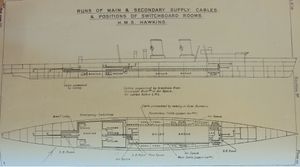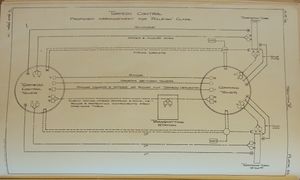Difference between revisions of "Hawkins Class Cruiser (1917)"
(→Mechanical Aid-to-Spotter) |
(→Mechanical Aid-to-Spotter) |
||
| Line 25: | Line 25: | ||
===Mechanical Aid-to-Spotter=== | ===Mechanical Aid-to-Spotter=== | ||
| − | By 1919, all the ships were likely equipped with four [[Mechanical Aid-to-Spotter Mark II*]]s, with Elliott's Bearing Transmission. The installations | + | By 1919, all the ships were likely equipped with four [[Mechanical Aid-to-Spotter Mark II*]]s, with Elliott's Bearing Transmission. The installations generally consisted of placing one on each side of the foretop, driven by flexible shafting from a gearbox on the director tower.<ref>''Manual of Gunnery of H.M. Fleet, Volume III, 1920'', p. 35, 37.</ref> |
| − | + | ||
| − | + | ||
Supplies of these devices begane in June 1918.<ref>''The Technical History and Index: Fire Control in HM Ships, 1919'', pp. 25-6.</ref> | Supplies of these devices begane in June 1918.<ref>''The Technical History and Index: Fire Control in HM Ships, 1919'', pp. 25-6.</ref> | ||
Revision as of 12:36, 2 July 2012
Four of the five cruisers of the Hawkins Class (sometimes called the Raleigh Class or Effingham Class and (maddeningly!) Cavendish Class) that were ordered were completed as cruisers, but one was completed as the aircraft carrier Vindictive. Although their 7.5-in guns lent them to the notion of being heavy cruisers, their single pedestal mountings yet resembled the British model of an early light cruiser.
Contents
Machinery

Boilers
Engines
Generators
In 1916, it was approved that the ships were to be given four 105-kw dynamos at 220 volts.[2]
Armament
Guns
The guns had armoured shields of 1 inch thickness on the face, sides and top, weighing 7.25 tons.[3]
Torpedoes
- Two 21-in submerged broadside tubes forward, angled 90 degrees and horizontal.[4]
- Four 21-in above-water tubes, fixed and with gyro angle pads for adjusting torpedoes.[5]
Fire Control
Range Dials
As of 1920, the four ships completed as cruisers had a Range Dial Type H and a Range Dial Type J.[6]
Rangefinders
Mechanical Aid-to-Spotter
By 1919, all the ships were likely equipped with four Mechanical Aid-to-Spotter Mark II*s, with Elliott's Bearing Transmission. The installations generally consisted of placing one on each side of the foretop, driven by flexible shafting from a gearbox on the director tower.[7]
Supplies of these devices begane in June 1918.[8]
Evershed Bearing Indicators
The ships almost surely had Evershed gear for gun control from delivery, as approval for their outfits was issued in 1916.[9]
Dreyer Table
In 1918, it was planned that all five projected vessels receive Dreyer Table Mark I*s,[10] but it is unclear as to whether any of the ships received these or the more advanced types they are later recorded as possessing. By 1930, Hawkins had a Dreyer Table Mark IV* of unrecorded register number.[11] At that time, Frobisher and Effingham were noted as having Mark III* tables.[12] As Raleigh was wrecked in 1922, little is known of her equipment.
Fire Control Instruments
Torpedo Control
The torpedoes could be controlled and fired from the C.T. or the T.C.T., with firing keys routed through C.O.S.es in the T.S..
The CT had
- Two gyro angle transmitters
- Two order transmitters
- One range receiver (from T.C.T.)
- One range and torpedo deflection transmitter (to T.C.T.)
- One bearing transmitter (to T.C.T.)
The TCT had
- Two gyro angle transmitters
- Two order transmitters
- One range transmitter (to C.T.)
- One range and torpedo deflection receiver (from C.T.)
- One bearing transmitter (from C.T.)
The tubes had:
- Two gyro angle receivers, one from C.T. and one from T.C.T.
- Two order receivers, one from C.T. and one from T.C.T.
All three locations had fixed Navyphone connections to the other two, and the C.T. also had voice pipes to the torpedo tubes.
See Also
Footnotes
- ↑ Annual Report of the Torpedo School, 1916, Plate 48.
- ↑ Annual Report of the Torpedo School', 1916', p. 120.
- ↑ Technical History and Index, Vol 3, Part 28, p. 18.
- ↑ Annual Report of the Torpedo School, 1916, p. 35.
- ↑ Annual Report of the Torpedo School, 1916, p. 35.
- ↑ absent from Manual of Gunnery of H.M. Fleet, Volume III, 1920, p. 45.
- ↑ Manual of Gunnery of H.M. Fleet, Volume III, 1920, p. 35, 37.
- ↑ The Technical History and Index: Fire Control in HM Ships, 1919, pp. 25-6.
- ↑ Annual Report of the Torpedo School', 1916', p. 175.
- ↑ Handbook of Captain F.C. Dreyer's Fire Control Tables, 1918. p. 3.
- ↑ Admiralty. Pamphlet on the Mark IV* Dreyer Table, 1930, p. 6. Whether this was a true Mark IV* or an upgraded Mark IV is not known.
- ↑ Admiralty. Pamphlet on the Mark III* Dreyer Table, 1930, p. 1.
- ↑ Annual Report of the Torpedo School, 1916, Plate 85.
- ↑ Annual Report of the Torpedo School, 1916, p. 151.
Bibliography
